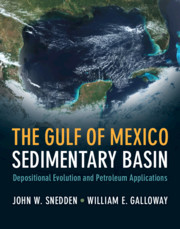Book contents
- The Gulf of Mexico Sedimentary Basin
- The Gulf of Mexico Sedimentary Basin
- Copyright page
- Dedication
- Contents
- Preface
- Abbreviations
- Part I Introduction
- Part II Mesozoic Depositional Evolution
- Part III Cenozoic Depositional Evolution
- Chapter 5 Cenozoic Depositional History 1
- Chapter 6 Cenozoic Depositional History 2
- Chapter 7 Cenozoic Depositional History 3
- Chapter 8 Cenozoic Depositional Synthesis and Emerging Hydrocarbon Plays
- Part IV Petroleum Habitat
- Glossary
- References
- Index
Chapter 8 - Cenozoic Depositional Synthesis and Emerging Hydrocarbon Plays
from Part III - Cenozoic Depositional Evolution
Published online by Cambridge University Press: 13 September 2019
- The Gulf of Mexico Sedimentary Basin
- The Gulf of Mexico Sedimentary Basin
- Copyright page
- Dedication
- Contents
- Preface
- Abbreviations
- Part I Introduction
- Part II Mesozoic Depositional Evolution
- Part III Cenozoic Depositional Evolution
- Chapter 5 Cenozoic Depositional History 1
- Chapter 6 Cenozoic Depositional History 2
- Chapter 7 Cenozoic Depositional History 3
- Chapter 8 Cenozoic Depositional Synthesis and Emerging Hydrocarbon Plays
- Part IV Petroleum Habitat
- Glossary
- References
- Index
Summary
Cenozoic history of the Gulf of Mexico basin was dominated by changing rate and geography of sediment supply. Most sediment entered through eight fluvial–deltaic axes along the northern basin margin, and one axis in Campeche. Deltaic depositional systems constructed the continental platform along these axes. Strike-reworking in coastal and shelf systems infilled the bights between deltaic depocenters. Depositional offlap of delta- and shelf-fed slope aprons prograded the shelf edge about 200 km (125 miles) from its Cretaceous precursor. Abyssal plain submarine fan systems were deposited during the Paleocene and Middle Miocene–Pleistocene. Sediment bypass from basin-margin uplands directly to the deep basin dominated the western GoM until the Neogene; tectonic margin aprons and submarine channel systems dominated. Pervasive gravity and salt tectonics produced a diverse array of extensional and compressional structures. These, in turn, create a great variety of trap configurations that help make the Gulf a global petroleum giant.
- Type
- Chapter
- Information
- The Gulf of Mexico Sedimentary BasinDepositional Evolution and Petroleum Applications, pp. 231 - 246Publisher: Cambridge University PressPrint publication year: 2019
- 1
- Cited by

